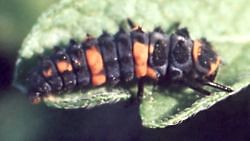Ladybugs
by Valerie (July 5, 2000)
revised November 11, 2003
There are lots of helpful insects when it comes to battling the pests that tend to destroy our desired plants. For this reason, I almost never use any kind of insecticide, and just let the insects battle it out; and their life and death struggles make our gardens much more interesting. Ladybugs, also called lady or ladybird beetles, come in a large number of different species, colors, and sizes. Members of the large family Coccinellidae, they are all shiny, rather small, sort of round, and have short legs. Both the larvae and adults eat aphids and other insect pests. Some have more spots than others, some have no spots at all, and the colors range from yellow to deep red to black. Just like their prey, the ladybugs' numbers fluctuate from year to year, depending on conditions and the availability of their food supply.
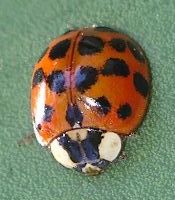 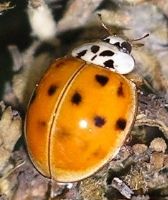 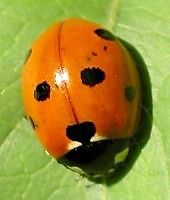 A species of similar size that I find occasionally is the seven-spotted lady bird beetle (Coccinella septempunctata). This lady beetle, pictured above at right, is more consistent in its pattern of spots, which makes it pretty easy to identify.
The larvae of lady bird beetles are very distinctive, especially in the way their legs seem to end without any claw (they really do have a claw at the end, but it is very tiny); they just look like someone drew stick-figure legs on them. The photo at right is the larva of the multi-colored Asian lady beetle, while the photo below it is of a different species, possibly the convergent lady beetle (Hippodamia convergens) or a related species. They are never more than 1/2 inch long, but they remind me of a gila monster, in both their bumpy texture and the combination of black and orange markings. Lady beetle larvae can often be found crawling about in vegetation as they hunt for aphids.
Before the ladybug larva metamorphoses into the adult beetle, it forms a pupa. In preparation for this, the larva attaches its rear end to a leaf or branch and hangs upside down, sort of humped over. Much like butterflies, it splits out of its old skin, which then forms a little nest of spines around the base of the pupa. The multi-colored Asian lady beetle larva shown below at left is ready to pupate, while the other two photos below show different angles of the pupae of the same species. Eventually the fully-formed adult beetle emerges after splitting out of the pupa skin.
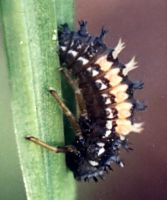  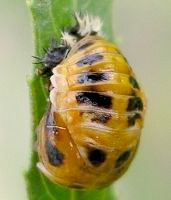 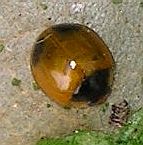 
There are also a couple of smaller lady beetles that we've seen in our gardens. One, shown at left, has no spots and is only about 1/8 of an inch long. It belongs to the genus Exochomus, but I haven't been able to identify the species. Another very tiny beetle, at right, is the dusky lady beetle (Scymnus socer), which measures just over 1/16 of an inch. This insect is so small that it looks a bit like a tiny seed that happens to move about. It is all black with reddish brown markings around the edge and is also sort of hairy if you can see it well enough to discern such detail. In spite of its tiny size, it still preys on aphids, just like its larger cousins, and I've only seen it when they are present. In colder areas, ladybugs gather in large numbers to hibernate, but here in Austin we just notice that there are usually several hanging about under the eaves of our house, or sometimes in the house, when the weather turns cool. Because they do no damage to anything and don't bite, there is no reason to be concerned about their presence in the house and they are easy to remove. |
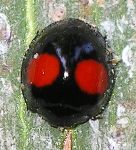
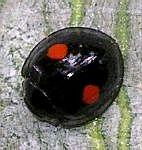 Another very common species is the twice-stabbed lady bird beetle (Chilocoris stigma). The individuals of this species are all the same color, black with two red spots, but the size of the spots can vary considerably. These lady beetles are smaller than the previous two species, being less than 1/4 inch in length. Because of their preference for scale insects, they are usually found around one of our silver maple trees which often has branches infected with these pests. Recently, the entire trunk of a nearby Chinese parasol tree became covered with white scale. Within weeks, there were also numerous twice-stabbed lady bird beetles as well. Unlike other species of ladybugs in our yard, this one has the habit of pupating in large numbers. The pupae may be found in clusters of up to two dozen, hanging from the underside of branches or along the trunk of the tree. I identified the species of a group like this when a severe freeze killed several of the pupae, including a couple that were partly emerged as adults.
Another very common species is the twice-stabbed lady bird beetle (Chilocoris stigma). The individuals of this species are all the same color, black with two red spots, but the size of the spots can vary considerably. These lady beetles are smaller than the previous two species, being less than 1/4 inch in length. Because of their preference for scale insects, they are usually found around one of our silver maple trees which often has branches infected with these pests. Recently, the entire trunk of a nearby Chinese parasol tree became covered with white scale. Within weeks, there were also numerous twice-stabbed lady bird beetles as well. Unlike other species of ladybugs in our yard, this one has the habit of pupating in large numbers. The pupae may be found in clusters of up to two dozen, hanging from the underside of branches or along the trunk of the tree. I identified the species of a group like this when a severe freeze killed several of the pupae, including a couple that were partly emerged as adults.

